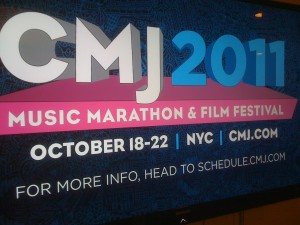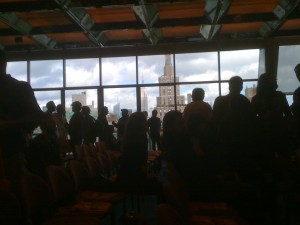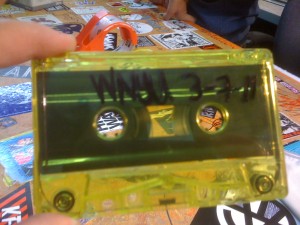Last week I was in New York City for the CMJ Music Marathon. As always, the city was packed with bands and college radio DJs who were either in town to discover the next big thing or in town to be discovered.
My focus, as it has been the past few times that I’ve attended, is to see how radio is represented during the festival. CMJ still serves as an industry publication for college radio, with stations all over the country (and Canada) submitting their charts to CMJ on a weekly basis. Back when I first started attending the convention in the 1980s, the CMJ Music Marathon was a chance to meet record label representatives and pick up promo albums. In those days, the exhibit hall was filled with record labels giving away vinyl and cassettes. Times have changes and much of the exhibit hall in 2011 was taken up by technology solutions for both stations and bands. A few tables had free music promoting artists from specific countries (Taiwan, Ireland).
For college radio folks, the main event was College Day on Thursday, October 20. Panels, performances, free food, and the College Radio Awards were the draw at the packed, day-long event on the 10th floor of the Kimmel Center at NYU. In this post, I’ll recap two of the panels that took place during College Day.
College Radio Events: From On-Air Stunts to Pony Rides
The first panel, “Eventus Maximus: How to Organize, Plan & Host a Killer Event,” offered tips for stations planning various types of events. In-studio performances, benefits, and shows co-presented at local clubs seemed to be the most common types of events thrown by the members of the panel. Innovative ideas for events and fundraisers included bake sales, kids’ dance parties at a night club, DJ on-air stunts (“make animal noises for money”), and the recent College Radio Day (one station offered pony rides). All of the panelists agreed that social networking tools (Facebook, Twitter, You Tube, etc.) were crucial in terms of getting the word out about their stations. Rob Wilcox, a radio promoter from The Syndicate, pointed out that a station’s Twitter feed can provide a “secondary personality” for the station. Some stations, such as KEXP, go so far as to have a separate Twitter feed for the tracks played over the air.
Is a 60-year-old College Radio DJ Problematic?
The next panel, Music Directors’ Summit, featured four college radio music directors talking about the ins and outs of working in college radio.
The first topic that they broached was the role of community member DJs at their stations. Moderator Greg Khaikin’s question to the group referenced stations that “have to include” community DJs and the struggles related to “dealing with people…who’ve been at the station for 20 years.” Erin Wolf, Music Director at WMSE at Milwaukee School of Engineering, said that her station is made up of DJs ranging in age from their 20s to their 60s. She said that students make up a small percentage of their DJs, but that she would like to have more students on the air. She added that the students, “don’t always know that we’re there” and acknowledged that, “we need to work more” to spread the word that the station exists.
The situation couldn’t be more difficult at New York University station WNYU. Music Director Maria Sherman said that last semester more than 100 students applied to be on the air. WNYU does also have DJs from the community who have been on the air for a long time. Sherman said that many of them have a large listener base and that it would be “silly” to take them off the air. Allan Benedict of WLUW said that at his station about half of the DJs are students and half are from the outside community. From 2002 to 2008, the station functioned as a listener-supported community radio station. Things changed in 2008 when Loyola University Chicago “assumed more control” of the station and shifted WLUW to more of a student station. Today the station’s executive staff is made up entirely of students.
Is the Digital Revolution Inevitable?
As in years’ past, the panelists also discussed the challenges of digital servicing from record labels and promoters.
In the olden days of college radio, labels sent out vinyl, cassettes, and CDs to college radio stations in the hopes that the material would get airplay. In today’s economy, fewer labels are willing to spend the money to produce and mail physical copies of music, so many of them send digital copies of tracks instead. Music Directors often say that this ends up creating more work and expense for stations.
Benedict argued, “I really don’t like the logistics of it,” saying that it’s “time consuming and kind of a hassle” to download tracks, burn CDs, and print out label art. Sherman added, “Our DJs do prefer physical media” and said that WNYU still does receive a lot of CDs and vinyl from smaller record labels. Wolf agreed, saying that WMSE has an “all physical” music library. Marissa Greenberg, Music Director of Pace University station WPUB, said that it’s exciting to get physical music in the mail, saying, “I love opening a package.” She also explained that WPUB doesn’t even have a computer, so dealing with digital releases is particularly challenging.
Despite a preference for physical music, many music directors are working to digitize their music libraries, even it it’s just as a back up. Benedict said that they are “slowly” working their way through the 13,000 CDs in their library and are mainly digitizing new material as it’s added to their library.
Tensions Dealing with Promoters
One aspect of a music director’s job is to interact with record label representatives and promoters who are working to get their music not only added to college radio station playlists, but also are looking for evidence of airplay in a station’s weekly charts. Sometimes this interaction with the music industry is positive and congenial, yet other times it is adversarial as some aggressive reps try to pressure music directors to add their music.
Greenberg, who started her music directing career at her high school radio station, said that she got really upset after receiving an email from a promoter that “wasn’t super nice.” She said that she sought out advice from her peers and ended up handling it professionally, telling the promoter that what gets played by DJs at her station is “out of my control.” Khaikin, who works as a promoter at the Planetary Group, said that some promoters are “too pushy with stations” and that it can verge on “bullying.” Wolf said that when asked by promoters why a certain record isn’t getting played, she simply tells them, “it’s because DJs can play whatever they want.”
Khaikin added that it’s important to just “be completely open and honest with your promoter.” He reflected back on his days as a music director and said, “Don’t let the promoter get in the way of the music for you” and “don’t let people push you around.” Greenberg added that she’s been asked to chart music that isn’t actually getting played. She eschewed that practice, saying, “stay true to what’s actually being played.”
Does College Radio Need to Fear Spotify and Rdio?
The conversation then turned to music services like Spotify and Rdio and the question was raised as to whether or not they are luring away college radio listeners. Benedict said that he views them simply as “tools” to help spread the word and are actually ways to help a station “branch out.” Greenberg contrasted Spotify with college radio, saying, “we have interactions with our listeners.” Khaikin agreed, adding that, “Spotify can’t turn you on to bands that you’ve never heard of before.” However, many of the panelists said that their stations had developed mobile applications, which they found useful for connecting with listeners.
Spreading the Word about New Music
During the Q&A session with the audience, the music directors shared some tips about ways to screen new music and share that music with DJs. Some hold listening sessions and others invite DJs to write reviews. Wolf said she posts charts and sends them to DJs and Khaikin said that he used to send an weekly email to DJs describing all of the new music adds. Sherman even hosts a radio show in which she focuses on new music from the past 3 months. Wolf also shares some of her favorite picks on the station’s blog, where she highlights a “song of the day” for both DJs and listeners. A DJ in the audience added that it’s a great idea to have a notebook in the studio so that DJs can write comments back and forth about the music that they like. The challenges in getting some DJs to branch out musically was described by Khaikin who said that there isn’t much “crossover” between what students listen to and what’s played on college radio. He added that the average age of a college radio listener is between 23 and 30.
Connecting with One’s Campus
An ongoing challenge for many stations is getting the word out on campus. Benedict talked about doing mix CD exchange events on campus. Greenberg said that at her station they asked a film student to make a commercial to help promote the radio station. Others mentioned throwing campus parties featuring DJs from the station spinning music. Additionally, campus newspapers publish charts for some stations. Wolf said that they are having an architecture student design the station’s new studio. Khaikin pointed out that it can be really helpful to involve students from other departments and Greenberg added that DJing for other campus clubs can be a great way to get a station’s name out.
Stay tuned for most posts recapping CMJ 2011. Previous posts include:
CMJ College Radio Awards Winners Announced
CMJ Announces Nominees for 2011 College Radio Awards
Nominations Open for 2011 CMJ College Radio Awards






